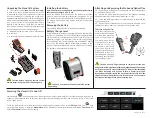
Humphrey Field Analyzer II - i
Appendix H
Confidential and Proprietary
52235C1105
H - 3
Field Service Guide
6 =
Wedge Attenuation
To help quantify the attenuation of the film and glass wedges, additional data has
been added to the calibration printout.
This information is intended for manufacturing
and engineering use and is not required for field service evaluation
. The
Working Film
Wedge Steps
displayed on the calibration printout indicates the total attenuation of
the film wedge. The
Working Glass Wedge Steps
indicates the total attenuation of the
glass wedge. Both are expressed in centibels (10 centibels equals 1 decibel). The
Total Working Wedge Attenuation
displayed on the calibration printout is the com-
bined attenuation of the
Working Film Wedge Steps
and
Working Glass Wedge Steps
,
also expressed in centibels. The
Total Working Wedge Attenuation
must be greater
than 500 centibels.
Bins Film
and
Bins Glass
displayed on the calibration printout
are used to evaluate the linearity of the NVM ND Table 0 film wedge and NVM ND
Table 1 glass wedge. Ideally, the amount of attenuation between any two adjacent
glass or film wedge motor steps should increase between 1, 2, or 3 centibels.
However this may not always be the case and is not a requirement for service
evaluation.
7 =
NVM ND Table 0
This is the
film
wedge calibration table stored in Cal/Config Data. The values in the
table were obtained during the latest wedge calibration. During wedge calibration,
brightness of the projected spot is sensed for 175 different positions of the wedge.
With a properly calibrated film wedge, the values printed should run from
approximately 0 – 370 in a linear progression, with no large jumps in value between
adjacent positions. If a large jump in value is noted, check the wedge for finger-
prints, scratches, debris, or flaking emulsion.
8 =
NVM ND Table 1
This is the
glass
wedge calibration table stored in Cal/Config Data. The values in the
table are obtained during the wedge calibration process. During wedge calibration,
brightness of the projected spot is sensed for 175 different positions of the wedge.
With a properly calibrated glass wedge, the values printed should run from approxi-
mately 0 - 270 in a linear progression, with no large jumps in value between adja-
cent positions. If a large jump in value is noted, check the wedge for fingerprints,
scratches, debris, or flaking emulsion.
Summary of Contents for humphrey HFA II-i series
Page 4: ......
Page 179: ......
Page 235: ......
Page 236: ......
Page 237: ......
Page 238: ......
Page 239: ......
Page 240: ......
Page 424: ...Page 4 FA2i 013A PROPRIETARY and CONFIDENTIAL...
Page 502: ...FA2i 041 Page 3 Figure 2 Press rectangle in Top Left corner...
Page 516: ...Page 2 FA2i 046 Figure 1 Glass Film Wedge Detectors P N 67417 Note Spacing Washer Placement...
Page 517: ...FA2i 046 Page 3 Figure 2 Y Motor Turret Detector P N 67418 Note Spacing Washer Placement...
















































